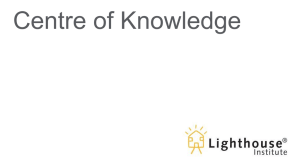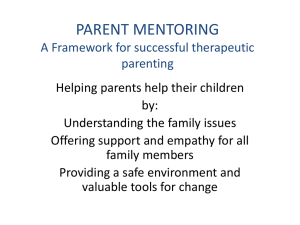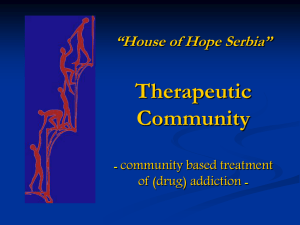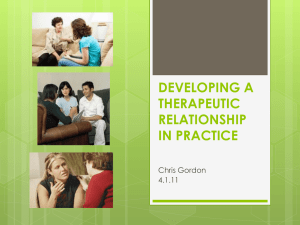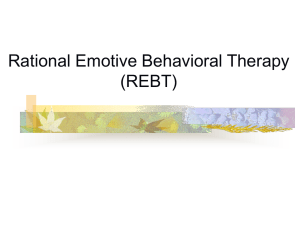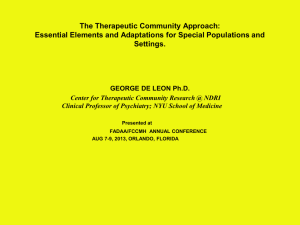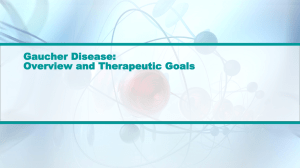Gonzalez
advertisement
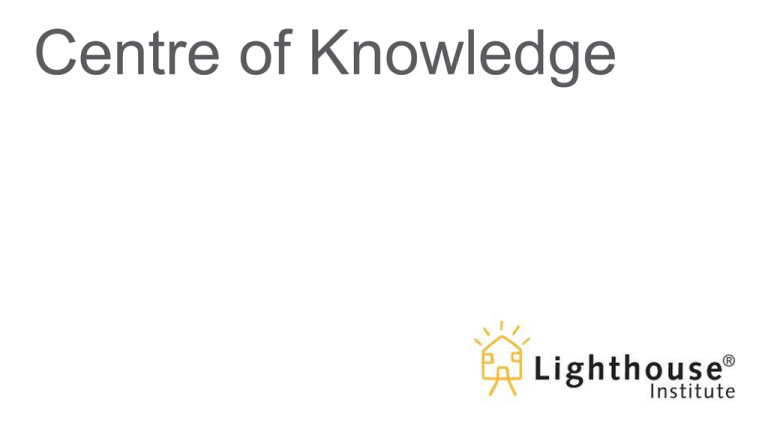
Centre of Knowledge Supporting Recovery from Trauma: Lighthouse Therapeutic Family Model of Care™ Rudy Gonzalez, Executive Director What Do We Mean by Trauma? A frightening or distressing event resulting in a psychological wound or injury Difficulty coping or functioning Resulting In normally following a particular event or experience Single Complex One-off, out of the blue, time-limited Repetitive, prolonged, cumulative, chronic Impersonal – natural disaster, accident Interpersonal, direct harm, exploitation, maltreatment Out of context – coming from a stranger In the context of relationships, i.e. primary caregivers, significant others, responsible adult No relationship to a person’s place in life Often occur at developmentally vulnerable times – early childhood or adolescence Eg. Road accident, flooding, robbery E.g. Poverty, homelessness, incarceration, exposure to death/ violence These examples are for illustrative purposes only and are not intended to minimise the effects of any trauma on an individual Theoretical Underpinnings • Attachment Theory • Object Relations Theory • Psychological Wellness Theory • Trauma Neurobiology Object Relations Theory - Winnicott • Prime motivational drive in humans is to form relationships with others • Style of relationship that develops in infancy to early childhood becomes part of an internal blueprint or a learned way of relating to others • Past relationships are replicated when we establish and maintain future relationships, which impact on our sense of identity • People from traumatic relational environments may have difficulty in forming and maintaining constructive and healthy relationships Object Seeking Behaviour “It is as if in early childhood we create a script for a drama and then spent the rest of our lives seeking out others to play the parts. This does not mean the script cannot be changed. However, the more traumatic our early selfobject relations, the more rigid and resistant to change we become” (Klee, 2009). Projective Identification In projective identification the person who is targeted with the projection begins to behave, think, and feel in a way that is consistent with what is being projected into him Projection Projective Identification Collective W Personal Relational Wellness can only be achieved through the combined presence of personal, relational and collective wellbeing Impact of Trauma on Development Developmental vs. Chronological Age An understanding of how the brain develops has significant implications for us in our work with traumatised people. It is natural that we first of all relate to a person in a chronological way. We see a middle aged person and we have normal expectations of a person that age. However, if a person has been severely traumatised in early childhood their brain may not have developed at a pace with their chronological age. If a person has been so traumatised that the limbic and cortex parts of the brain are largely undeveloped, this person may be functioning in many respects as a child. Barton, Gonzalez & Tomlinson (2012) Activity Trauma Organised System Young Person Worker Manager Angry/aggressive Helpless Feel unsafe Angry/aggressive Helpless Hopeless Hopeless Hyperaroused Hyperaroused Fragmented Fragmented Overwhelmed Overwhelmed Confused Confused Depressed Demoralised ORGANISATION Feel unsafe STAFF Young Person Parallel Process Is unsafe Punitive Stuck Missionless Crisis Driven Fragmented Overwhelmed Valueless Directionless The Flow of Trauma YP Worker Manager What is Recovery from Complex Trauma? The goal of therapy is to get children back on their developmental pathway Anna Freud Recovery is when the child has internalised the therapeutic process Rudy Gonzalez Organisational Trauma Informed Practice Systems Recovery Process • Therapeutic Relationships • The Group • Therapeutic Environment • The Organisation • The Community Therapeutic Relationships Michelangelo described his work as a sculptor as a process of removing the excess marble concealing the beauty of the figure within. His job, he was reported to have said, was a process of uncovering rather than creating. Working with people is often like this. Working effectively with people requires that you create and shape relationships that are therapeutic…. Fuller (1998) Therapeutic Group Processes Recovery from injuries perpetrated in a social context must occur in a social context. These centers, responsible for healing, must become therapeutic communities where recovering is more important than control, and compassion and empathy drive out fear and coercion. (Farragher & Yanosy, 2005) When supervision takes place in a group setting, a greater range of feedback, support, challenges and viewpoints on clinical issues can be obtained. When group dynamics are managed effectively, and the emotional aspects of the supervision process are attended to, the group supervision setting can provide invaluable resources that are not available in the context of individual supervision. Andersson (2008, p.36 - 38) Andersson (2008, p.36 - 38) Therapeutic Environment Traumatised people benefit from caring environments that are attuned to their emotional states. Where workers can adjust the environment to support emotional regulation, and can provide predictable responses and routines that assist in reducing hyper-arousal. (Tucci, Mitchell and Goddard, 2010) Organisations As Therapeutic Settings All staff role model a healthy sense of community Internalised by the YP Provides a therapeutic milieu Operations/ relationships attuned to the therapeutic task Organisation The Organisation as Therapist Relationships, language, communication, leadership and authority = Environment experienced by child Variety of relationships & circle of care The Community Sense of community: The feeling that one is part of a readily available supportive and dependable structure. Sense of community transcends individualism in that to maintain such an interdependent relationship one does for others what one expects from others. Sarason (1974) Overview of the Model Home Individualised Care PLACE Playful, Loving, Accepting, Caring, Empathetic Individual Professional Development Plan Development Plan Staff Therapeutic/ Recovery Oriented Family Developmentally Focussed Not Chronologically Sense of Community Primary Experience Time/Holding Space TFMC Process of Recovery Individual Development Plan Learning Physical development Emotional development Attachment Identity Social development Autonomy / life skills Relational and community Connectedness Fun / play / recreation Transition planning Psychological Healing Process Identity confusion Attachment difficulties Holding space Trauma work Dealing with loss and rejection Developing insight and awareness Building trust in relationships Internal working models Developing autonomy New skills consolidation Confidence in relationship building Lighthouse Process Time-frame Intake Induction Weeks / Months Lighthouse Home Months / Years Transition After Care Months / Years www.lighthouseinstitute.org.au
